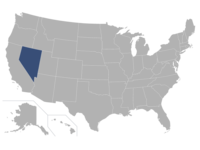Nevada 988 hotline in-state answer rates among nation’s lowest

Despite being one of only five states that passed legislation to fund the 988 National Suicide Prevention programming, Nevada had one of the nation’s lowest percentages of calls answered within state borders, according to a Kaiser Family Foundation report that compared answer rates nationally.
Only Texas, Alabama, South Carolina and Florida had lower in-state answer rates.
When calls aren’t answered locally, they are “routed to an out-of-state overflow facility or are abandoned by their caller,” according to the Kaiser report.
In July, when the 988 program was launched in the U.S., researchers writing in an American Psychiatric Association journal noted that “answering calls within the same state as the caller is considered to be a best practice because crisis center staff can effectively connect callers to local resources.”
People who call 988 have a roughly 50-second period of navigating the call system, while asked if they are a veteran or if they need specific languages and other questions, before they are routed to the crisis call center that is associated with their phone number. A delay in answering that crisis call, even if it’s a few seconds, can lead someone to disconnect before ever talking to someone, said Rachelle Pellissier, executive director of Crisis Support Services of Nevada.
The Kaiser report analyzed in-state answer rates in December, and found 65% of of calls from Nevada area codes were answered in the state, a significant drop from the rate of 77% in July 2022 when the 988 number launched. More recently, Nevada’s in-state answer rates are still some of the nation’s lowest, at 71% in January and 75% in February, well shy of an initial 95% goal.
The report also noted that factors affecting in-state answer rates include “how much and how long it invests in its local call centers and broader crisis services”
State legislation enacted in 2019 directs telecommunications companies to collect a 35-cent fee surcharge on phone bills, but it has yet to be implemented. In the interim, the Crisis Support Services, the nonprofit that has overseen the state’s suicide hotline for over 50 years, continues to bare the brunt of the nearly 30% increase in call volume since the 988 number was enacted in July of last year with minimum staffing.
When asked why there was a delay in putting the funding process in action, Pellissier said “That’s a question for the state.”
The Division of Public and Behavioral Health plans to launch the initial process to determine which providers will be given the contract for administering the funding for 988, said Shannon Litzt, the public information officer for the Nevada Department of Health and Human Services Director’s Office.
A bill has been introduced in the current legislative session to clarify the surcharge. The Nevada State Board of Health approved temporary regulations to collect the fees to fund 988 in January and regulations were approved by the Secretary of State on March 7, but there is a 90-day delay for the initial collection of the fees to ensure that telecommunications have time to prepare. The Division of Public and Behavioral Health anticipates the first fees being collected in July 2023, Litzt said.
The data Kaiser analyzed from December 2022 is from Vibrant, the national system that reviews all of the call rates for every crisis hotline in the country. The answer rates are comparable to those reported by Crisis Support Services. December is a unique month in data collection as the nation’s 988 system was down for nearly a day due to a cyberattack.
Nevada ranks at the bottom of all states in access to care and higher prevalence of mental illness, according to the nonprofit Mental Health America’s annual rankings.
The state also ranks 14th in the nation for death by suicide, it is the second leading cause of death for those between the ages of 10-34 in the state, according to the Centers for Disease Control and Prevention (CDC). Nearly 42% of Nevadan children felt hopeless for two or more weeks and 22% seriously contemplated a suicide attempt, according to the 2021 Youth Risk Behavior Surveillance System by the CDC.
As the local need continues to grow, Crisis Support Services also serves as one of the national hotline hubs for 988, so a crisis call can be routed from elsewhere in the nation to them. While the nonprofit increased staffing by 35 people, it has not been enough to keep up with the growing demand.
The 988 number for the National Suicide Prevention Lifeline is intended not only to connect people in emotional distress to 24-hour, 7-day-a-week free and confidential support, but is also step one in creating the nation’s first comprehensive crisis behavioral health care system based on having someone to call, someone to come and somewhere to go.
While the 988 hotline is the first step in the national creation of a continuum of care for people in crisis, states vary in their preparedness to build out the other pieces of the infrastructure.
Nevada is one of the few states to enact a dedicated funding mechanism for 988, the other four being California, Colorado, Virginia, and Washington. In addition to the delays implementing that funding, Nevada’s rollout has encountered other barriers, including a shortage of staffers fluent in languages and in cultural competency for the AAPI community, the need to build mobile crisis teams and crisis stabilization centers from the ground up, and a transient population.
Nevada’s preparedness is also hampered by a lack of coordinated behavioral health services in place beforehand, a reflection of the state’s poor rankings in mental health services.








